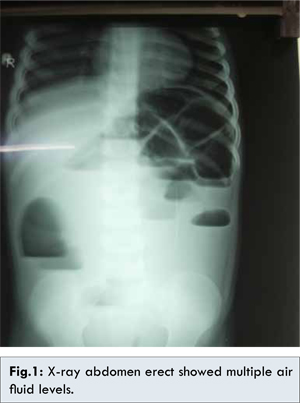Introduction
The most common cause of intussusception is idiopathic. Intestinal malrotation has been postulated as cause of intussusception in view of mobile right colon. The association between intestinal malrotation and intussusception is known as Waugh’s syndrome. We present a case of Waugh’s syndrome which was associated with mesenteric adenitis and Meckel’s diverticulum.
Case Report
A 2 year old, male child developed acute abdominal pain, abdominal distension, bilious vomiting and bleeding per rectum. His abdominal pain was localized around umbilicus with no radiating and relieving factors. Examination revealed a febrile child with tachycardia. He had a distended abdomen with tenderness around umbilicus but no palpable mass. There was maroon colored blood and mucous on rectal examination. Routine blood examination revealed Hb: 13.4 gm%, TLC: 12800/cu mm, DLC: P48, L37. Kidney and liver function tests were within normal limits. X-ray abdomen erect revealed multiple air fluid levels and ultrasound abdomen was suggestive of intussusception with proximal obstruction [Fig.1].

After maintenance of hydration and broad-spectrum intravenous antibiotics, the patient underwent laparotomy. Manual reduction was done for ileo-colic intussusception noticed during exploration which also had few dark hemorrhagic patches but was considered still viable. After reduction there was about one an inch long diverticulum present over anti-mesenteric part of intussuscepted bowel and considered to be Meckel’s diverticulum. Wedge resection of Meckel’s diverticulum was done [Fig.2]. Mesenteric adenitis was also present so lymph node biopsy was taken [Fig.3]. On further exploration Ladd’s band was also present with malrotation so Ladd procedure and appendectomy were performed.
Postoperatively he had satisfactory recovery. Histological examination confirmed that appendix had lymphoid hyperplasia with serosal congestion. Resected part of ileum containing diverticulum showed inflamed Meckel’s diverticulum with gangrenous changes and lymph node biopsy showed reactive hyperplasia.
Discussion
Intussusception has emerged as one of the common causes of intestinal obstruction in an infant [1,2]. The association of intussusception with malrotation is referred as Waugh syndrome [3,4]. It has been suggested that malrotation is often associated with a mobile right colon which may be a pre-requisite for intussusception [4].
The distribution of intussusception between the sexes is roughly equal, however the occurrence of symptomatic Meckel’s diverticulum is predominant in the male and the sex ratio ranges from 2.5:1 to 7.0:1 [6]. The incidence of acute intussusception with Meckel’s diverticulum is 2.5%. [7].
The etiology of intussusception is idiopathic in 81% of cases. The other 19% were divided into two groups those where a definite causative pathology was present and those where a contributory pathology may have had a bearing on the condition. In the first group they included Meckel’s diverticulum, polyploidy masses and lymph sarcomata and in second hypertrophied Peyer’s patches, bands, ascariasis and tumefaction of the ileocaecal valve [5]. An intussusception with Meckel’s diverticulum is almost invariably of the ileo-ileal type and does not progress beyond the ileo-caecal valve perhaps because the apex of intussusception is too large to pass through.
Air enema reduction of the intussusception may be complicated by midgut volvulus in children with Waugh syndrome and should be investigated to rule this out after the procedure. Malrotation should be looked for and treated if present when reducing intussusception to prevent midgut volvulus after operation.
Our patient presented with acute sign and symptoms suggestive of acute intestinal obstruction and per-operative diagnosis of intussusception was made. However, the most important findings of our case were its association with malrotation, Meckel’s diverticulum and mesenteric adenitis.
Conclusion
Occurrence of intussusception along with malrotation being rare, any case of intussusception needs proper preoperative investigation to rule out association of malrotation. Once diagnosed these cases must undergo correction of malrotation along with management of intussusception because malrotation may cause volvulus. .
References
- Mangete EDO, Allison AB. Intussusception in infancy and childhood: an analysis of 69 cases. West Afr J Med 1994;13:87-90.
- Nmadu PT. The changing pattern of infantile intussusception in Northern Nigeria: a report of 47 cases. Ann Trop Paediatr 1992;12:347-350.
- Brereton RJ, Taylor B, Hall CM. Intussusception and malroation in infants: Waugh syndrome. Br J Surg 1986;73:55-57.
- Breckon VM, Hadley GP. Waugh syndrome: Report of six cases. Pediatr Surg Int 2000;16:370-373.
- Peck DA, Lynn H]B, Dushane JW. Intussusception in children. Surg Gynecol Obstet 1963;116:398-404.
- Soderlund S. Meckel’s diverticulum in children; a report of 115 cases. Acta Chir Scand. 1956;110(4):261-274.
- Taddeo MC, Janes HH. Intussusception due to invaginated Meckel’s diverticulum after previous appendectomy. Am J Surg 1955;89(3):696-699.